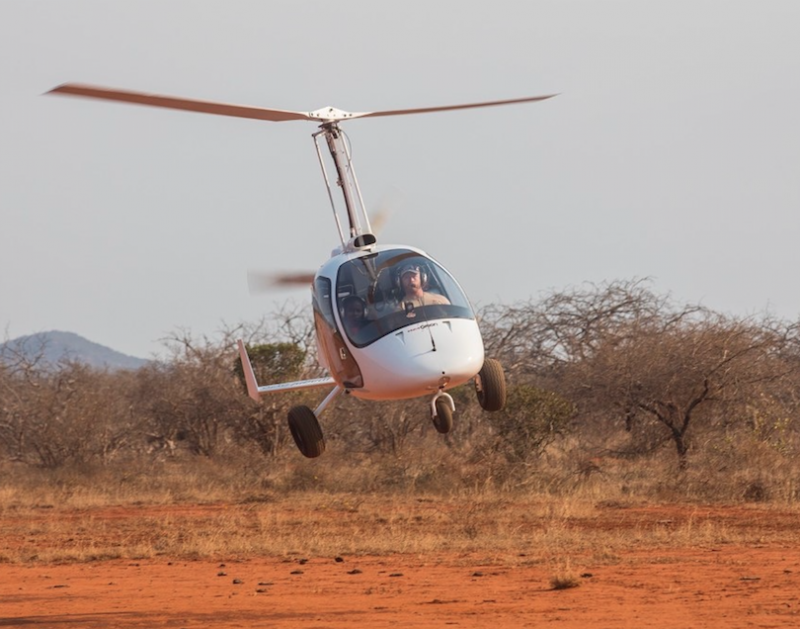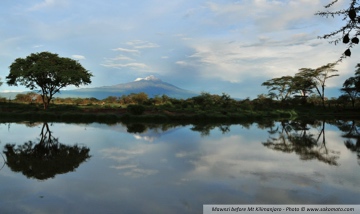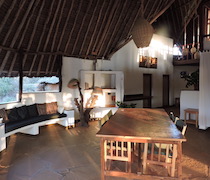Flying for Conservation
Keith Hellyer, anti-poaching gyrocopter pilot, flies daily over vast tracts of Tsavo. It was fascinating to speak to him about his day-to-day life supporting the rangers in their fight to save Kenya's wildlife.

What brought you to Kenya?
My family brought me on safari when I was 10. I saw my first lions and elephants, was immediately hooked, and that set me on my path to what I’m now doing. I returned to Kenya as soon as I could and started working in tourism. It was then that I saw first-hand the enormous challenges wildlife faces in Kenya – and that made me want to do my bit to help.
So you became a gyrocopter pilot?
Actually that was just by chance. I learned to fly the gyrocopter for fun. It was just a hobby. But I quickly realised the gyrocopter’s potential, and saw what a useful tool it could be for wildlife surveillance. It’s affordable – about a quarter of the price of other aircraft with similar capabilities – and its manoeuvrability makes it ideal for observing wildlife at low-level altitudes.
Tell me about the job.
I’m a contract pilot for Wildlife Works, and my funding comes partly from Save the Elephants and partly from public fundraising through the Elephant Protection Trust. Wildlife Works is an incredible project. Mike Korchinsky founded it in 1997 on the principle that the needs of wildlife must be balanced with the needs of the people who share their environment. He developed a plan that would protect wildlife by providing people in wildlife-rich areas with jobs; and he chose an area with a high threat to wildlife – Rukinga Sanctuary in the Kasigau Corridor between Tsavo East and Tsavo West National Parks – in which to implement his plan. Now of the 15,000 elephants in the Tsavo ecosystem, about 2,000 rely on this corridor in their search for water and as a migration route. And they’re not the only species to live in or come through the area. My daily flights are always exciting: I see lions and elephants most days, and am often treated to a sighting of a rare species like honey badger or wild dog.
It sounds exciting, but aren’t there risks?
Flying at low-altitude is risky, especially over the thick Commiphora forest that covers much of the area. I flew into a flock of vultures once – that didn’t go well for the vultures or the gyrocopter. Landing on bush airstrips is a tricky experience every time; they can be full of buffaloes, or giraffes, or kudus. And dodging piles of elephant dung to take off is a challenge!
How did Wildlife Works encourage so many animals to return to the area?
It’s their protection of the environmental habitat that makes this project special. We’re not just protecting one particular species, but protecting a massive belt of pristine wilderness outside the national parks. The REDD+ programme – Reducing Emissions from Deforestation and Degradation – is the world’s first REDD+ project to receive issuance of carbon credits, and was awarded Gold level status by the Climate, Community and Biodiversity Standard.
It works through what’s called consumer-driven wildlife conservation – the creation of jobs for people who previously had little option but to destroy their environment just to survive. So where I live, there are not only over 100 rangers, but people in the T-shirt factory, in the soap factor, in the eco-charcoal project and more, all employed by the projects Wildlife Works has established.
What’s an average day like for you?
I usually wake up before sunrise to communicate with the Head of Security for Wildlife Works. We make a plan based on what happened the previous day, and what happened during the night. Depending on that, I’ll either survey a random location, or I’ll head somewhere we suspect illegal activities have taken place. I fly with a ranger who records the numbers of elephants we see, as well as other species of interest such as Grevy zebra and lions. We also look for charcoal burning and other illegal activities.
If we see a freshly poached carcass, we relay the information to our team who tells the Kenya Wildlife Service. If we’re lucky enough to have spotted the poached animal before its tusks were taken, I guide the KWS team to the area and watch to keep them safe while they confiscate the ivory. Otherwise, I work with them – guiding them and protecting them from above – to try to track the poachers.
It’s a pretty simple story of a boy and his plane.
Tamara Britten, 10 September 2021
Published also in: Nomad Magazine
About the region
Tsavo West

Tsavo West National Park has a diverse array of habitats, including open grasslands, rocky outcrops, isolated hills, riverine vegetation, palm thickets and mountain forests. Highlights include Mzima Springs, Ngulia Rhino Sanctuary, Lake Jipe, Shetani Caves and spectacular views of Mt Kilimanjaro. Over 600 species of birds have been recorded here.
Read more about Tsavo WestWhere to stay
Tsavo Conservancy is an important migration corridor between Tsavo East and Tsavo West, enabling animals to roam freely between the two national parks. The conservancy comprises 7 group ranches, giving the area improved conservation management and increased job opportunities for the local communities. Kivuli Camp, in ...
